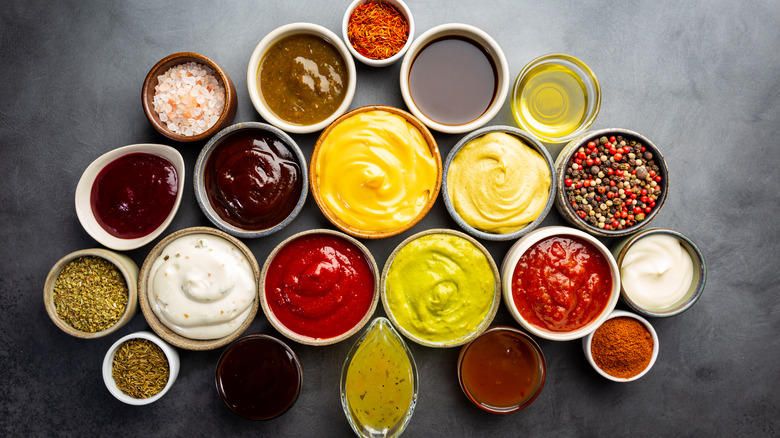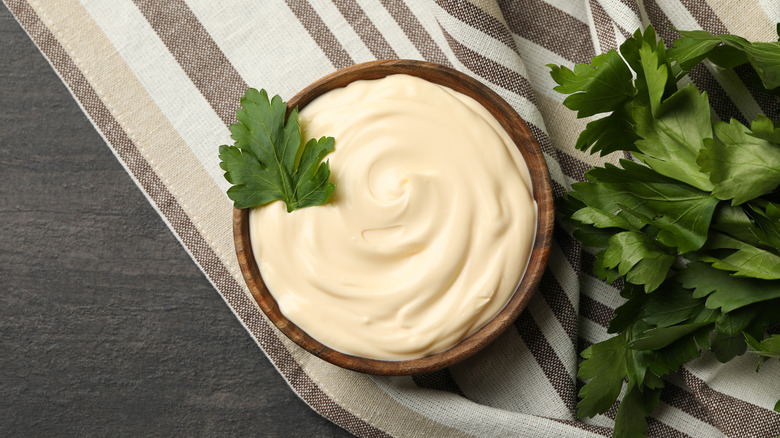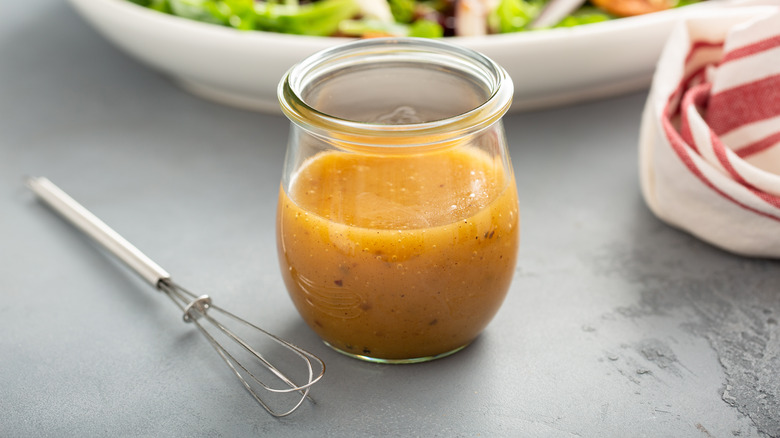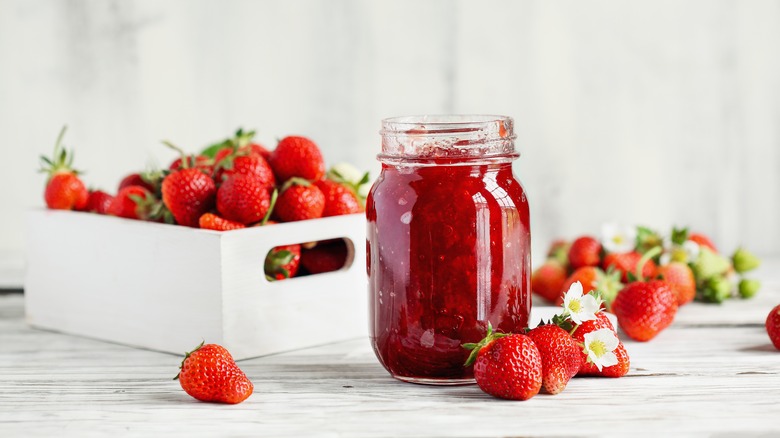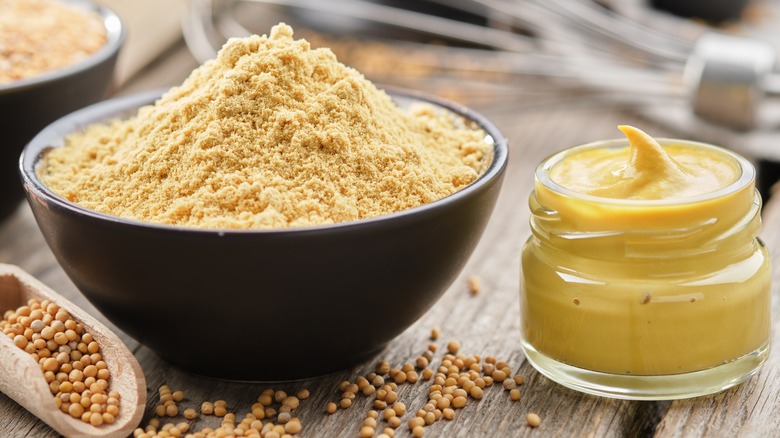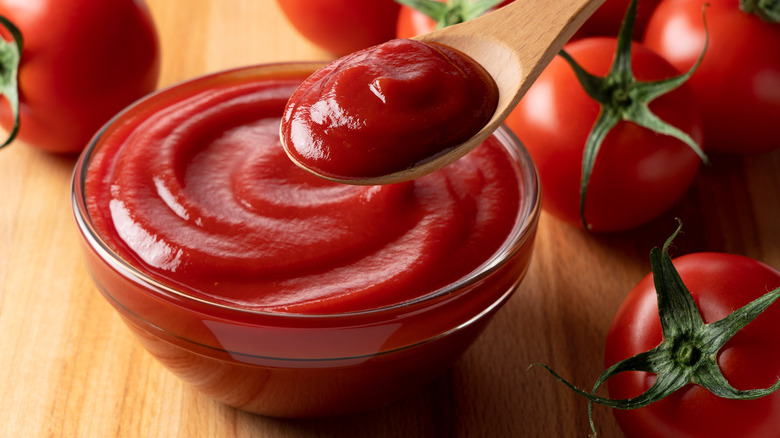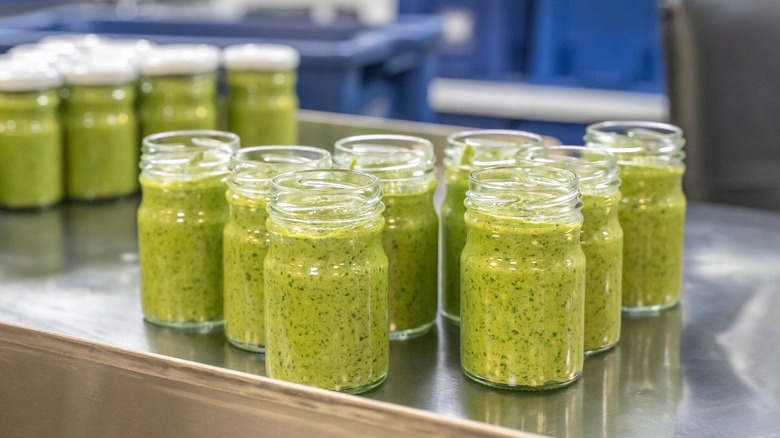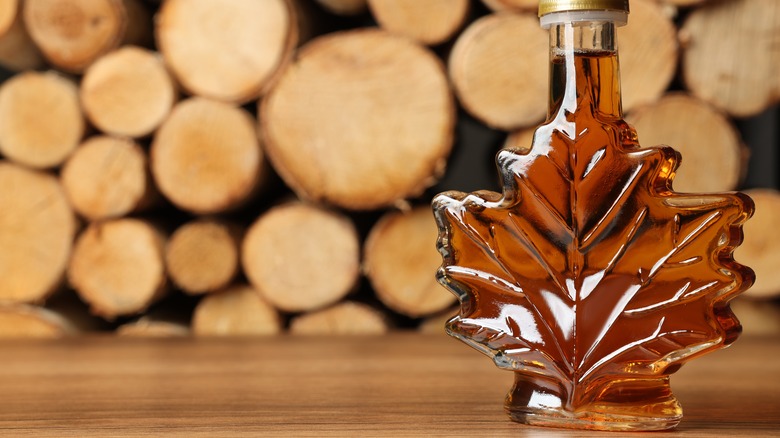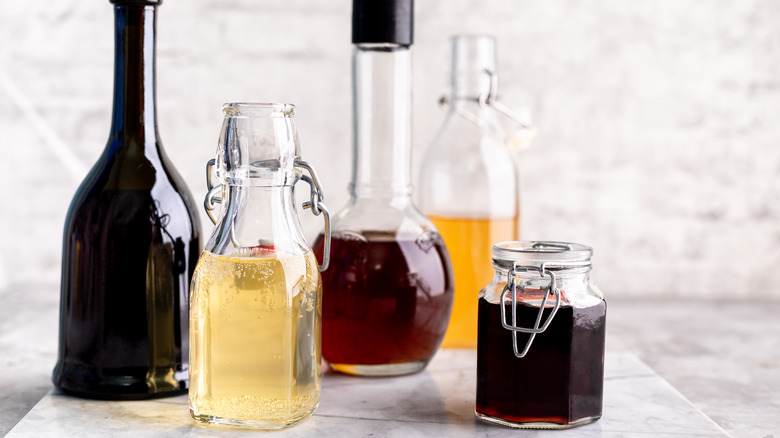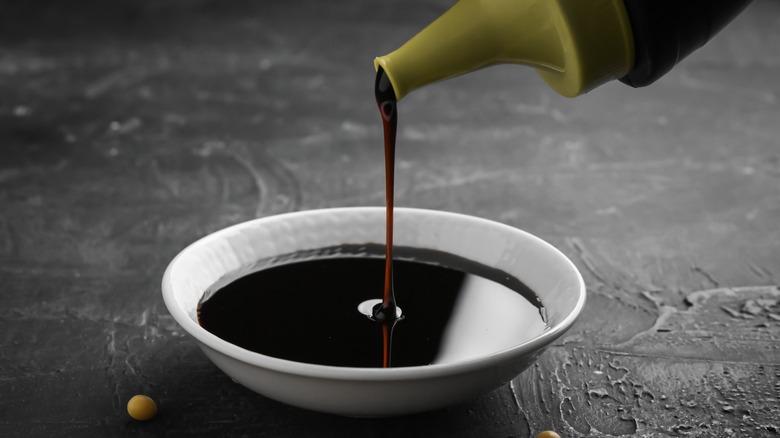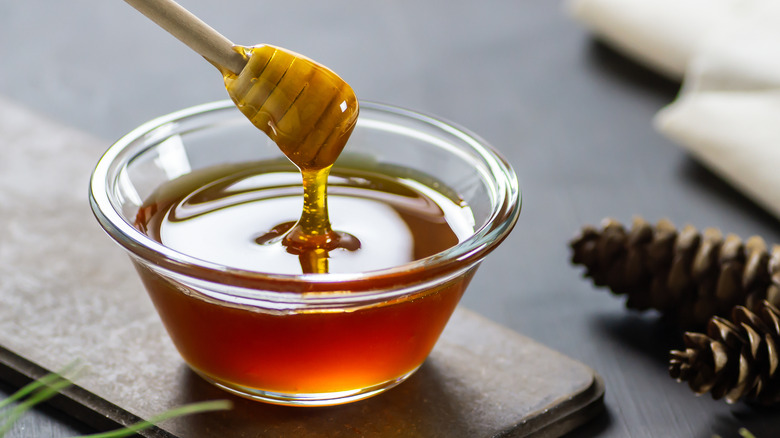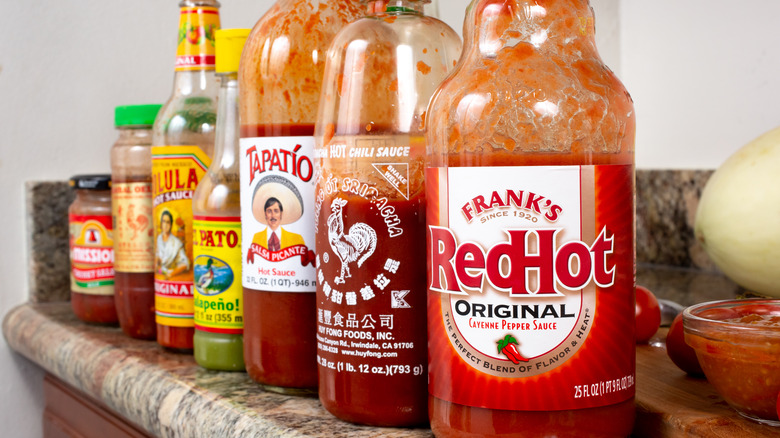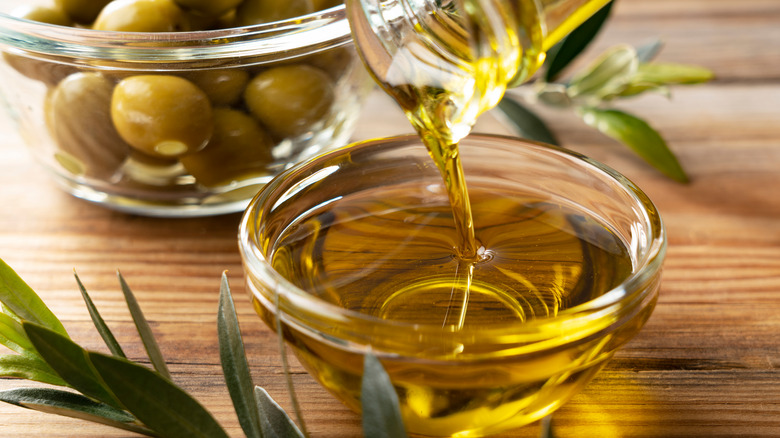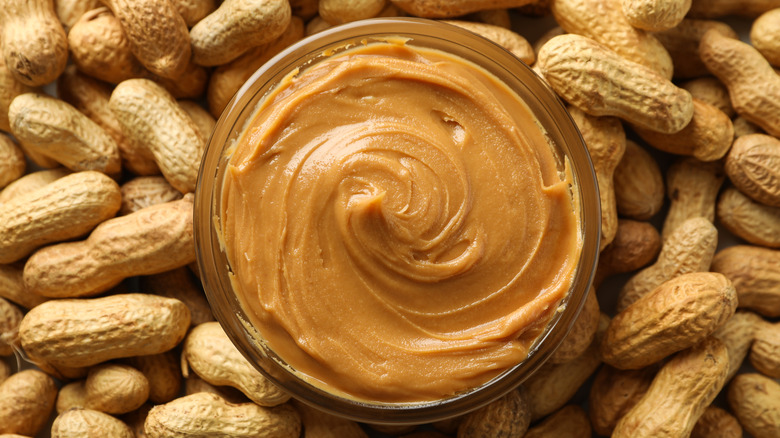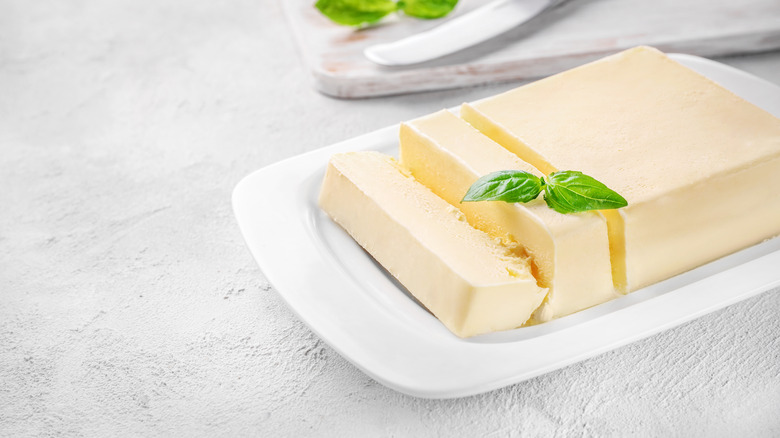7 Condiments You Need To Refrigerate And 7 You Don't
Condiments are an important part of most kitchens. From mustard to soy sauce, these products add zest and flavor to our food, and most of us couldn't imagine eating a meal without some sort of sauce or dressing. While deciding which condiments are the best is an argument in itself, some of the biggest controversies about these foods revolve around their storage. Perhaps you keep your hot sauce in the fridge whereas your friend swears it's a waste of space. On the flip side, you might visit someone's home and be horrified to see warm butter sitting on the counter.
While there are differing opinions about how to store condiments, as well as some items that are safe both refrigerated or not, everyone should be aware of a number of food safety rules. Many of the common ingredients found in condiments quickly go rancid unless kept at a certain temperature, putting you at risk of getting sick. Here are the condiments you definitely want to refrigerate and the ones that will be fine in your pantry.
Mayonnaise
Mayonnaise is made from an emulsion of eggs, oil, and vinegar. When you purchase mayo at the grocery store it is not refrigerated, so you may wonder if it's necessary to put your jar in the fridge when you get home. According to Amy C. Keating, a registered dietitian and nutritionist, this condiment is shelf-stable after being packaged in sterile airtight containers (via Hunker). That being said, the sterile environment disappears once you open the jar.
Although the acid in mayonnaise makes it more difficult for bacteria to grow, this condiment can still go bad when left outside of the fridge. Keeping it cool in the refrigerator slows down bacterial growth and reduces the risk of catching a bug after making a sandwich. Mayo that is stored outside of the fridge is also likely to turn a funky brown color, which isn't something you want to see. So while you can keep your mayonnaise in the pantry after purchasing it from the grocery store, make sure to stick it in the fridge immediately after you open it.
Salad Dressing
There are plenty of varieties of salad dressing and most need to be kept in the refrigerator. Many contain dairy for added creaminess and flavor. Ranch dressing, for example, contains buttermilk, while Caesar dressing traditionally contains Parmesan cheese. The U.S. Department of Agriculture (USDA) lists dairy products as perishable foods that must be refrigerated for safety reasons. Therefore, if salad dressing contains any dairy product, including milk, yogurt, or cheese, it needs to be in the fridge.
The USDA lumps salad dressing with mayonnaise among the products that need to be refrigerated after opening, regardless of the specific brand or type. Like mayonnaise, you can find some dairy-based salad dressings sold as shelf-stable products in the grocery store. Similarly, these need to be refrigerated after opening.
Even if your salad dressing doesn't contain dairy, it probably still belongs in the refrigerator. Many salad dressings contain other perishable ingredients such as fruit and citrus that can go bad more quickly when left unrefrigerated. Unless your salad dressing only consists of vinegar and olive oil, it's best to stick it in the fridge.
Jellies and Jams
Jelly and jam are some of the most popular condiments out there, responsible for creating delicious toasts and the famous PB&J. While some types of jelly can be stored at room temperature, most people prefer to keep their preserves in the fridge. And for good reason; according to food safety specialist Nicole Richard, an open jar of jelly will develop mold more quickly if left unrefrigerated (via Martha Stewart). Keep in mind that these products can still grow mold in the fridge, so you're best off using them within a reasonable time frame.
As with other items, most store-bought jams and jellies can be kept outside of the refrigerator as long as the jars remain sealed. However, once you open the jar, it's best to stick it in the fridge. The FoodsGuy blog notes that you might be fine keeping your jelly or jam in a cool dark pantry after opening it, but only if you plan on using it up within a week or two. You should also be aware of the signs that your jelly or jam has gone bad, including visible mold, severe discoloration, and bad odors.
Mustard
Since mustard has limited ingredients and is very acidic, it seems like a product that doesn't need to be refrigerated. And that's because it doesn't really. According to Yahoo, you don't have to refrigerate mustard for safety reasons. However, you'll still want to keep those bottles and jars in the fridge for the ideal taste experience. The McCormick company, which sells French's mustard, notes that the flavor of Dijon or horseradish mustard will fade if not chilled, while other types simply keep longer in the cold.
Mustard is made from ingredients that don't really spoil, like vinegar, mustard seed, and other spices, so this condiment won't go bad as Ranch dressing does. While unrefrigerated mustard can last for several months past the sell-by date, the flavor will start to change and the consistency will become more watery over time (via Does it Go Bad?). Dry, unpleasant mustard will probably go in the trash, so keeping it in the fridge will guarantee it lasts as long as possible. If you want your mustard to retain the sharp tangy taste we all know and love, store it with these extra precautions.
Ketchup
There has been a long debate about where to keep ketchup. Most people seem to prefer to keep it refrigerated, and Heinz, the leading manufacturer of ketchup, recommends refrigerating it after opening for best results. However, other people prefer to keep ketchup in the pantry, as do many restaurants that leave bottles out all day and night. Given the high-acid ingredients it contains, ketchup is actually shelf-stable.
However, many people still recommend that you keep your ketchup in the fridge. Like mustard, this condiment can dry out and separate more quickly when left on the counter. While you probably won't get sick, it can negatively affect the flavor and texture of the product. Today leaves it up to personal preference; if you like room-temperature ketchup then keep it on the counter, and if you like it cold then keep it in the fridge. Just be sure to use it up as quickly as possible if you're not refrigerating it.
Pesto
Pesto is made with many ingredients that don't really go bad quickly — namely, olive oil, garlic, Parmesan cheese, and pine nuts. However, since pesto contains dairy products and fresh herbs, it should be kept refrigerated. Once opened, pesto can last for about a week in the fridge, according to Does it Go Bad? That being said, it will likely start to change color and flavor after a few days. If you want your pesto to retain its original flavor, then be sure to use it up as quickly as possible. Unopened pesto sold in an airtight container with preservatives will remain shelf-stable until opened, like many of the condiments on this list.
A good option to extend your pesto's shelf-life is to freeze it. Lacademie blog recommends storing pesto in ice cube trays for easy portioning later on. You can also freeze pesto in an airtight container. Be vigilant of signs that the condiment has gone bad, which include visible mold, severe discoloration, and bad odors.
Maple Syrup
Most people probably don't think twice about where they store maple syrup. However, you should know that unrefrigerated maple syrup will spoil much more quickly than if it's kept in the fridge. Pure maple syrup does not contain any preservatives, so it needs to be refrigerated after opening in order to prevent mold and bacteria from growing (via Better Homes and Gardens). Citadelle explains that keeping it cool can also reduce the likelihood that some of the moisture in the container will evaporate and turn the syrup into crystals.
Table syrup, or the fake stuff made from sugar, water, and other flavors, may contain enough preservatives to safely stay outside of the fridge, but you should always follow the manufacturer's guidelines on the back of the bottle to be safe. Given that some brands recommend refrigerating it and others indicate it's safe to keep in the pantry, you're best off approaching each product individually.
Vinegar
As for condiments that do not need to be refrigerated, the household staple vinegar is fine at room temperature. According to the University of Nebraska-Lincoln, unopened vinegar can be stored in a pantry or cupboard for two years while opened vinegar can be kept for one year. Many other sources, including The Vinegar Institute, argue that vinegar's shelf life is indefinite. Since vinegar is so acidic, it inhibits the growth of mold and bacteria. While it might change color or flavor over time, this will not make it unsafe to consume.
You might notice that some types of vinegar, such as balsamic or apple cider, are sold in dark glass bottles. This is because light can cause these kinds of vinegar to deteriorate more quickly. The shelf life of balsamic, for example, is only three to five years, as opposed to the endless time frame of the plain white stuff (via Old Town Oil). If your vinegar is stored in a clear bottle, you should consider transferring it to a dark container if you plan on keeping it for a long time.
Soy Sauce
Whereas spare soy sauce packets from old takeout orders probably sit in a drawer in your kitchen, your bottle of soy sauce might be in the fridge. So where does this condiment really belong? While you're free to keep it chilled if you want, soy sauce can safely be stored in your pantry. Because this condiment is made through a fermentation process, it is able to be left at room temperature for a while (about a year) without spoiling, according to PureWow.
However, it's important to note that soy sauce will change color and flavor over time, especially when exposed to oxygen and sunlight. If you notice your soy sauce has started to turn brown or tastes different than usual, it's probably time to toss it. According to Does it Go Bad?, other signs of spoiled soy sauce include white floaties, an odd smell, or a difference in texture. If you're not going to refrigerate your soy sauce, keep it in a cool dark cabinet for the best results.
Honey
Honey is known as one of the only food products that don't spoil. According to Beehive Hero, honey stored in a sealed container and kept away from sunlight can last indefinitely. Keeping your honey in the refrigerator can actually be bad for it since the cool temperature thickens the consistency and makes it impossible to squeeze out of the bottle until it warms up again. If you notice your honey is starting to crystallize or has changed color, this doesn't necessarily mean it has gone off. You can simply place the jar of honey in a pot of hot water for a few minutes to reverse the process.
The only reason you should discard honey is if it has clearly spoiled and shows a significant color change or even visible mold. This should not happen with pure honey, as the bacteria that cause food to go bad cannot survive in pure honey. However, some honey products may contain other ingredients that can indeed spoil. Be sure to check the ingredient list and store the container according to the manufacturer's instructions if it isn't pure honey.
Hot Sauce
Much like vinegar, hot sauce is extremely acidic, meaning bacteria and mold have a hard time growing in it (via Southern Living). Given this fact, most hot sauces do not need to be refrigerated. There are many different varieties of hot sauce, but most can last for several years after opening before losing their flavor. Cholula hot sauce, for example, can be enjoyed for up to six months after being opened while Louisiana Hot Sauce can last up to five years.
If you're unsure whether or not your hot sauce needs to be refrigerated, check the ingredient list. If it contains vinegar, water, and salt as its main ingredients, it doesn't need to be refrigerated. However, if your hot sauce also consists of dairy products or fresh vegetables, it should be stored in the fridge. You should also throw out any product if the flavor or texture has changed significantly.
Olive Oil
Like honey, olive oil is another condiment that really should be kept out of the fridge for optimal results. According to About Olive Oil, storing olive oil in the fridge can cause it to solidify and form crystals. While this can be reversed by bringing the oil back up to room temperature, it will add extra steps to your cooking process and won't give you the best oil experience. If you're looking to prolong the shelf life of your olive oil, the best way to do so is by storing it in a cool dark place like your pantry.
Another way to make sure your olive oil lasts as long as possible is by investing in a dark glass bottle with a tight-fitting lid (via Olive Oil & Beyond). Light and oxygen are two of the main factors that cause olive oil to go bad, so storing it in a sealed container will help it last longer. Also, be sure to avoid vessels made from reactive metals such as copper or iron, as these can produce toxins that make your oil unhealthy to consume.
Peanut Butter
Since nuts can go rancid over time, it's not crazy to store your peanut butter in the refrigerator. However, this product does not need to be refrigerated, according to Healthline. Ideally, peanut butter should be stored in a cool, dark place in an airtight container though. Again, light and oxygen are two of the main factors that cause peanut butter to go bad, so storing it in a sealed vessel will help it last longer. Keep in mind that homemade and natural peanut butter should ideally be kept cool since both are made without preservatives (via Food Network).
According to the National Peanut Board, a jar of peanut butter that has not yet been opened can last for six to nine months in the pantry. Meanwhile, an open jar of peanut butter will last about two to three months before it begins to deteriorate in quality. One perk of refrigerating your peanut butter is that it can last longer (about six to nine months in the refrigerator after opening). However, the downside to chilling this condiment is that it becomes firm and harder to spread until it warms up again.
Butter
If you're used to storing your butter in the refrigerator, you were probably shocked the first time you saw someone storing it on the counter. Most dairy products need to be refrigerated, after all. Butter, however, is the exception. According to the USDA, butter (and margarine) are safe to consume at room temperature. The department does recommend using it within two days though because the flavor can go rancid when it's left out any longer than that.
According to Healthline, the safest kind of butter to leave on the counter is salted butter because salt can ward away bacteria growth. Since light can cause butter to go rancid more quickly, be sure to invest in a butter tray with a lid to protect it from oxygen and light. You'll also want to keep it away from the stove in the coolest, darkest part of your kitchen for the best results. If you can't create these optimal conditions or won't use up the butter in two days, it's best to keep it in the fridge for safety. You can always pull out a stick of butter and warm it up on the counter when you need it.
